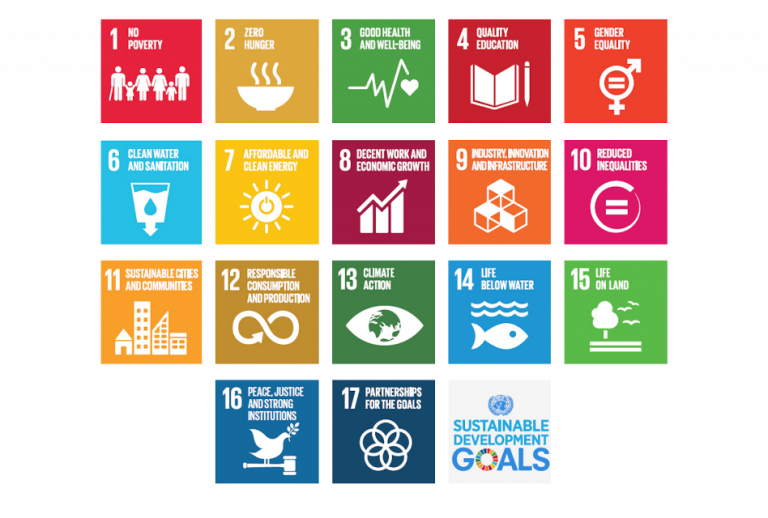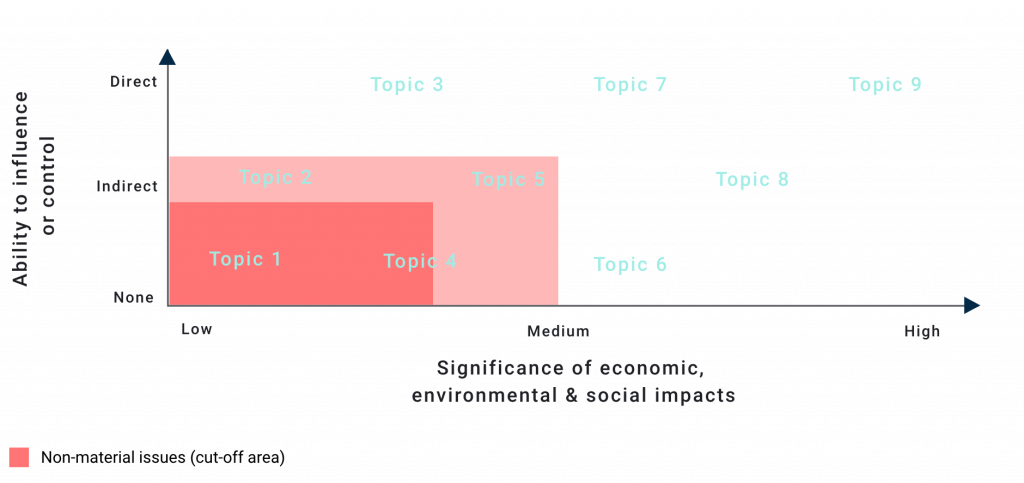Chapter 03
Start! How to navigate the future.
When entering the jungle of sustainability frameworks it is easy to get lost. Truth be told, there are certainly more standards than needed. Building on different constituencies – from NGOs to investors – and following distinctive rationales – from accountability to impact – they all provide meaningful guidance. But there is also a lot of room for confusion. So, here is some helpful advice on how to navigate different stakeholder expectations: from a smart and focused selection of helpful sustainability frameworks to applying a good degree of common sense.
After this chapter, you…
- know the difference between accountability-driven standards and impact-driven standards
- have an illustrative map of the ecosystem you operate in
- know the material sustainability topics for your business
Sustainability frameworks
Looking at the numerous sustainability frameworks out there, here are the three most important things you need to know to not get lost:
1. Accountability vs. Impact
Sustainability is as much about taking responsibility and being accountable for your actions and their consequences, as it is about creating a positive impact and systemic change. This duality is also reflected in the world of sustainability standards.
Accountability-driven standards are a good proxy for what stakeholders will expect you to take responsibility for. They also help you to understand which externalities you need to avoid to build a good business (read more about avoiding risks and negative externalities in chapter 5).
Impact-driven standards, on the other hand, can guide you in identifying current and future business opportunities that result from the current economic transformations moving our economy towards more sustainability. You will want to follow up with these if you want to make deliberate impact and be part of this change (read more about creating positive impact in chapter 6).
A global reference frame for sustainability
There is one last framework you must be familiar with: The Sustainable Development Goals (SDGs) by the United Nations. These 17 goals have created a universal playing field for sustainability. Anything that does not contribute to one of these goals cannot reasonably be considered “sustainable”.
Make sure you are familiar with them: The United Nations Sustainable Development Goals

Understand the system you operate in
You know your business better than anyone else. And the topic of sustainability is not totally new to you. So why not just apply some common sense rather than plow through hundreds of pages of standards documents?
Applying a systems perspective embedding your startup in the greater ecosystem you operate in, will help you identify the sustainability topics that really matter to your business. Standards and certifications should come second, supporting you in digging deeper and understanding more precisely how to go about the sustainability issues that you have carved out as relevant for you.
Here’s how you can go about uncovering the sustainability topics that are relevant for your long-term success:
Prepare an illustrative map of your ecosystem
- Draw-up your value chain (e.g. from raw material sourcing to product recovery at the end of its lifecycle or – if you don’t have a physical product – from purchasing your hardware and hiring to service delivery and application) and visualize material flows.
- Lay circles over your value chain representing the (sub-)systems you operate in (e.g. mobility, sports, and culture if you’re providing an urban lifestyle vehicle).
- Situate all the stakeholders you directly or indirectly interact with into the systems map.
- Discuss the map of your ecosystem with your key stakeholders (starting with your management team, key mentors, and possibly investors), and adjust and redefine until you feel comfortable with the depiction.
The Systems Map helped us to identify the risks and opportunities for our business, develop holistic objectives and to implement them meaningfully in terms of ecological, economic and social aspects for the long-term success of our company.
– Fazua
Here are some guiding questions for you to ask during that exercise:
- Systems serve a societal or individual human need. How well does the ecosystem you operate in already fulfill these needs?
- What are the side effects of this system? What are the external effects, e.g. waste you are creating by producing your product, or other effects of people using your product or service?
- What are (social or ecological) inefficiencies or challenges in the system?
- What is your vision for the system (to be distinguished from the vision of your firm as part of the system)?
- What must happen for that transition?
- What is the mission of your company and what problem are you solving?
- What are positive impacts (economic, social, environmental) of your solution/ when reaching your mission on the system?
- What are negative impacts (economic, social, environmental) of your solution/ when reaching your mission on the system?
- What are environmental, social, or governance (ESG) topics inside your organization?
Here’s a run-down of how you can assess the materiality of sustainability topics for your startup:
- Make a list of all the social, ecological, and governance issues you have identified to be relevant within your ecosystem.
- Assess your ability to influence or control each issue
- Define your own scale (e.g.: none | indirect | direct control).
- Make sure you do not define your ability to influence or control an issue just by the resources that might currently restrain you.
- Instead, evaluate your functional ability if you had the resources – think more in general about how a company producing products / offering services like yours can influence certain topics.
- Estimate the economic, environmental, or social impacts you could have if you remained inactive, continued, or started to engage on this very issue
- Again, define a scale that suits you best (e.g.: low | medium | high impact).
- Make sure that you factor in your current company size and reach when evaluating your potential impact.
- Don’t get frustrated with the methodological challenge to discern between positive and negative impacts. We’ll get to that. For the time being, just treat them identically or as if the difference didn’t matter.
If you prefer a more guided approach on identifying the topics you should consider taking action in, you can also take the “Operational Self Assessment” provided by START Global within their ROSE Framework. They will provide you with an initial evaluation of your current sustainability performance for free.
Once you’re done with the materiality assessment, you should have a clear sense of the sustainability issues that are relevant for your company: it’s those that matter within your ecosystem, that you can control and that you (could) have an actual impact on. Isn’t that excellent?
Next, you need to differentiate which of these issues are crucial for the long-term success of your company (Chapter 4) and which of them bear the potential to cause unintended negative impacts that could eventually harm your business (Chapter 5).
Let’s go!


